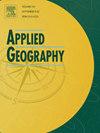Characteristics and spatial-temporal dynamics in agronomic landscape: Case study of Guangrong watershed, Northeast China
IF 5.4
2区 地球科学
Q1 GEOGRAPHY
引用次数: 0
Abstract
The distribution of crop sequences in terms of landscape position and ridge direction derived from fields is the most important element of agricultural landscapes. This landscape pattern is primarily attributable to the annual desires and actions of farmers. In this study, we proposed an agronomic landscape concept and a “field boundaries-landscape position-ridge direction-crop distribution” framework to evaluate changes in the agronomic landscape over time and space. We applied the framework to a typical small watershed in Northeast China. Based on remote sensing images from 2017 to 2022 and field surveys, we found that the maize-soybean rotation mosaic had an interannual alternate distribution in fields of high and medium landscape positions with an askew ridge direction, which dominated the agronomic landscape pattern of the watershed. Continuous soybean cropping fields were concentrated in the higher landscape positions with askew and strike ridges, and continuous maize cropping fields were concentrated in the medium and lower landscape positions with strike and cross ridges. This study presented a new insight into agricultural landscape analysis and would help improve cropland production based on agronomic landscape planning at a watershed scale.

农艺景观特征与时空动态——以光荣流域为例
作物序列在景观位置和田脊方向上的分布是农业景观中最重要的要素。这种景观格局主要归因于农民的年度愿望和行动。在本研究中,我们提出了一个农艺景观概念和一个“田界-景观位置-山脊方向-作物分布”的框架来评价农艺景观的时空变化。我们将该框架应用于东北典型小流域。基于2017 - 2022年遥感影像和野外调查,研究发现玉米-大豆轮作花叶在中高景观位田中呈年际交替分布,且垄向偏斜,在流域农艺景观格局中占主导地位。大豆连作田集中在较高的斜脊和走向脊景观位置,玉米连作田集中在中低的走向脊和交叉脊景观位置。该研究为农业景观分析提供了新的视角,有助于在流域尺度上基于农艺景观规划提高农田生产水平。
本文章由计算机程序翻译,如有差异,请以英文原文为准。
求助全文
约1分钟内获得全文
求助全文
来源期刊

Applied Geography
GEOGRAPHY-
CiteScore
8.00
自引率
2.00%
发文量
134
期刊介绍:
Applied Geography is a journal devoted to the publication of research which utilizes geographic approaches (human, physical, nature-society and GIScience) to resolve human problems that have a spatial dimension. These problems may be related to the assessment, management and allocation of the world physical and/or human resources. The underlying rationale of the journal is that only through a clear understanding of the relevant societal, physical, and coupled natural-humans systems can we resolve such problems. Papers are invited on any theme involving the application of geographical theory and methodology in the resolution of human problems.
 求助内容:
求助内容: 应助结果提醒方式:
应助结果提醒方式:


